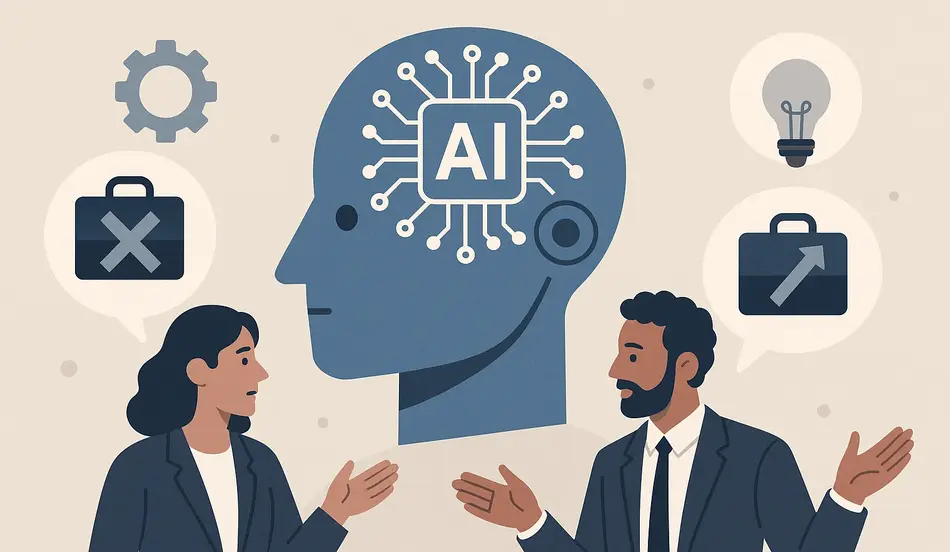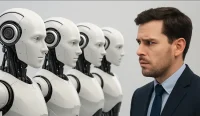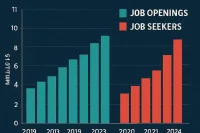How AI will impact the future of work
How AI will impact the future of work is one of the most critical questions of our time, with experts offering dramatically different perspectives on whether artificial intelligence will displace workers or create new opportunities. As AI and robotics advance to match and potentially exceed the capabilities of average workers, the future of employment hangs in the balance.
This comprehensive analysis examines the debate between AI optimists and pessimists, exploring the potential for massive job displacement while also considering the historical precedent of technological progress creating new opportunities and economic growth.
The great AI employment debate
The discussion around AI’s impact on work centers on two fundamentally different viewpoints:
The pessimistic view: Massive job displacement
Martin, representing the pessimistic perspective, argues that AI will inevitably displace at least half the workforce, possibly more. His reasoning centers on several key points:
- Direct competition with human intelligence – AI targets our core competence: cognitive capability
- General-purpose technology – Unlike previous innovations, AI will be deployed across all sectors
- No new sector to absorb displaced workers – Unlike the transition from agriculture to manufacturing to services
- Routine task automation – Most workers do predictable, routine tasks that AI can perform better
The optimistic view: Economic growth through technological progress
Betsy, representing the optimistic perspective, argues that AI will ultimately create more opportunities than it destroys:
- Historical precedent – Every major technological advancement has led to better living standards
- Economic growth driver – True economic growth comes from technological progress
- Increased consumption – AI makes production cheaper, leading to more consumption and job creation
- New job categories – History shows new sectors emerge to absorb displaced workers
Why this time might be different
Both experts acknowledge that AI represents a unique challenge compared to previous technological revolutions:
Targeting human intelligence
Unlike previous technologies that replaced human physical labor, AI directly competes with human cognitive abilities. As Martin explains:
“AI is going to directly displace what is our core competence, right? The thing that sets us apart is our intelligence, right? Our cognitive capability. That is what so far has always allowed us to adapt and remain relevant to the workforce even in the face of advancing technology.”
General-purpose deployment
AI isn’t limited to specific industries like previous technologies. It will be deployed across all sectors simultaneously, making it harder for displaced workers to find alternative employment in unaffected areas.
IQ advantage elimination
Betsy uses a powerful analogy to explain the threat:
“The problem with AI is the difference between right now there’s a bunch of people who have set up their status in society and their income in society by being 140 or 150 IQ person being a 100 IQ person. And that’s going to be the same thing as being like the really strong guy versus the average right strength guy in the future. It’s just going to be swamped when we have machines that are all at 300 IQ points.”
Current evidence of AI’s impact
Early signs of AI’s impact on employment are already visible:
Entry-level job pressure
Recent college graduates are experiencing higher unemployment rates (4.59% in 2024 vs. 3.25% in 2019), suggesting AI is already affecting entry-level positions that were traditionally safe for educated workers.
Launch Your Career with Confidence
With entry-level opportunities under pressure, it’s more important than ever to stand out. Post your resume on WhatJobs today and get noticed by employers actively hiring graduates in competitive fields.
Post Your Resume Free →Wage pressure before job loss
Betsy predicts that before massive unemployment, we’ll see significant wage pressure as humans compete with AI by accepting lower pay:
“What we could see happening is the wages of a lot of white collar workers facing downward pressure. And that I think is problematic. So it’s not a but I think that that’s much more likely to happen first before we see you know wide swaths of 50% of the population unemployed.”
Beyond white-collar jobs: The robotics revolution
While much attention focuses on AI’s impact on knowledge work, robotics presents an equally significant threat to blue-collar jobs:
Controlled environment automation
Robots are making rapid progress in controlled environments like:
- Amazon warehouses
- Manufacturing facilities
- Fast food restaurants
- Supermarkets
As Martin notes: “Within those controlled environments, warehouses, factories, I think eventually maybe even supermarkets, fast food restaurants, I think that robots are going to have a dramatic impact.”
Amazon warehouse example
Amazon’s warehouses already demonstrate how AI and robotics can work together to optimize operations in ways humans wouldn’t consider, such as grouping unrelated items in the same container based on delivery routes rather than logical categories.
Government’s role in managing the transition
Both experts agree that government intervention will be necessary to manage the transition, but they differ on the best approaches:
Tax system reform
Betsy advocates for fundamental changes to the tax system:
- Reduce taxation on labor – Stop discouraging human employment
- Increase taxation on capital – Level the playing field between humans and machines
- Subsidize human capital investment – Support worker training programs
Universal Basic Income vs. Digital Dividend
Both experts support income support programs but differ on implementation:
Martin’s Universal Basic Income approach
Martin advocates for a universal basic income to:
- Provide economic security for displaced workers
- Maintain consumer demand in the economy
- Allow people to find meaning outside of paid work
Betsy’s Digital Dividend approach
Betsy proposes a data dividend based on the value of personal data:
- Tax companies’ use of personal data
- Distribute proceeds to citizens as a dividend
- Recognize that data is a resource citizens contribute to AI development
The challenge of meaning and purpose
Beyond economic concerns, both experts worry about the psychological impact of widespread job displacement:
Jobs provide more than income
As Martin explains: “Jobs don’t just provide income, right? They provide a sense of dignity, a sense of self-worth. They occupy time. They give people a sense of meaning.”
Finding ikigai without work
Betsy references the Japanese concept of ikigai (life purpose) and notes that in societies where people live longest, purpose comes from civic engagement rather than paid work:
“Your ikigai is much less correlated with your income or your work and in fact what ikigai is most correlated with is your participation in civic society and volunteer groups.”
Education in an AI-driven world
The role of formal education is also being questioned as AI becomes more capable:
Sam Altman’s Gen Z envy
OpenAI CEO Sam Altman recently expressed envy for Gen Z college dropouts who have “mental space to build startups,” suggesting traditional education may be less valuable in an AI world.
Shift toward liberal arts education
Both experts agree that education should focus less on vocational training and more on:
- Critical thinking skills
- Human interaction abilities
- Creativity and artistic expression
- Civic engagement
Recommended fields of study
For students planning their careers, both experts recommend:
- Psychology – Understanding human behavior
- Economics – Analytical framework for decision-making
- Creative fields – Art, music, theater
- Skilled trades – Electricians, plumbers (harder to automate)
Timeline predictions
Both experts acknowledge the difficulty of predicting exact timelines, but offer some guidance:
Martin’s timeline
Martin originally thought massive displacement might take 50 years, but now believes it could happen much sooner as AI systems improve at:
- Addressing hallucination problems
- Building agent systems for complex tasks
- Integrating with existing workplace tools
Betsy’s gradual transition
Betsy expects a more gradual transition with wage pressure occurring before mass unemployment, similar to historical patterns of technological adoption.
Biggest concerns and hopes
Both experts share their greatest fears and hopes for the AI transition:
Martin’s concerns
- Economic disruption – Massive job losses and social upheaval
- AI bubble burst – Economic devastation from overinvestment
- Distributional problems – Benefits concentrated among few
Betsy’s concerns
- Social cohesion loss – Erosion of trust and community
- Political system failure – Crony capitalism limiting innovation
- Democratic institutions under threat – AI power concentrated in few hands
Shared hopes
Both experts are optimistic about AI’s potential to:
- Amplify human intelligence and creativity
- Drive scientific breakthroughs in medicine and technology
- Improve living standards for everyone
- Solve complex global challenges
FAQs
Q: Will AI displace 50% of workers as some experts predict?
A: Experts are divided on this question. Pessimists argue that AI will inevitably displace at least half the workforce because it targets human cognitive abilities directly. Optimists believe that while some jobs will be lost, new opportunities will emerge, similar to previous technological revolutions.
Q: What makes AI different from previous technological revolutions?
A: Unlike previous technologies that replaced physical labor, AI directly competes with human intelligence and cognitive abilities. It’s also a general-purpose technology that will be deployed across all sectors simultaneously, making it harder for displaced workers to find alternative employment.
Q: Are blue-collar jobs safe from AI automation?
A: No, blue-collar jobs are also at risk. Robotics combined with AI is making rapid progress in controlled environments like warehouses, factories, and fast food restaurants. However, jobs requiring human interaction in unpredictable environments may be safer longer.
Q: What should students study to prepare for an AI-driven economy?
A: Experts recommend focusing on fields that emphasize human skills: psychology, economics, creative arts, and skilled trades like electrical work or plumbing. The key is developing skills in human interaction, creativity, and critical thinking.
Live example — user point of view
As someone who’s been following the AI employment debate closely, I found this discussion really illuminating. I’ve been worried about my own job security as a knowledge worker, and hearing both perspectives helped me understand the complexity of the situation.
What struck me most was Betsy’s point about wage pressure happening before mass unemployment. I hadn’t really thought about that scenario, but it makes sense. Companies might keep human workers but pay them less as they compete with AI, rather than eliminating jobs entirely.
I also appreciated Martin’s point about AI targeting our core competence – intelligence. That’s what really differentiates this from previous technological revolutions. We’ve always been able to adapt by using our cognitive abilities, but what happens when machines are smarter than us?
The discussion about meaning and purpose really resonated with me too. I’ve always tied my identity closely to my work, but the idea that meaning can come from civic engagement and community involvement is something I need to think about more.
Overall, I’m still concerned about the future, but this discussion gave me a more nuanced understanding of both the challenges and opportunities that AI presents for the future of work.




